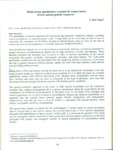Use este identificador para citar ou linkar para este item:
http://www.alice.cnptia.embrapa.br/alice/handle/doc/668211Registro completo de metadados
| Campo DC | Valor | Idioma |
|---|---|---|
| dc.contributor.author | SOUSA, N. R. | pt_BR |
| dc.date.accessioned | 2017-05-11T23:49:54Z | - |
| dc.date.available | 2017-05-11T23:49:54Z | - |
| dc.date.created | 1999-05-25 | pt_BR |
| dc.date.issued | 1999 | pt_BR |
| dc.identifier.citation | In: INTERNATIONAL SYMPOSIUM MULTI-STRATA AGROFORESTRY SYSTEMS WITH PERENNIAL CROPS, 1999, Turrialba. Multy-strata agroforestry systems with perennial crops: proceedings. Turrialba: CATIE, 1999. p. 204-207. | pt_BR |
| dc.identifier.uri | http://www.alice.cnptia.embrapa.br/alice/handle/doc/668211 | pt_BR |
| dc.description | It is discussed the growth of five forest species, testing the viability model for in field conservation that put together agroforestry production principles with genetic and ecological stability of natural populations of autochthonous plant species. The preliminary results bring out a possibility for tansferring the model through a participatory approach to family farmers, institution with landscape projects, communities assisted by by non-governamental organizations. In the model species used for production should be chosen by the model users, whereas the species used for conservation should be the ones indicated from research (pau-rosa, mahogany, or virola). | pt_BR |
| dc.language.iso | eng | eng |
| dc.rights | openAccess | eng |
| dc.subject | Agrofloresta | pt_BR |
| dc.subject | Camu-camu | pt_BR |
| dc.subject | Especie florestal | pt_BR |
| dc.subject | Tanimbuca | pt_BR |
| dc.subject | Buchenavia huber | pt_BR |
| dc.subject | Trattinickia burserifolia | pt_BR |
| dc.subject | Brasil | pt_BR |
| dc.subject | Amazonas | pt_BR |
| dc.subject | Manaus | pt_BR |
| dc.subject | Sustainability | pt_BR |
| dc.title | Multi-strata agroforesty systems for conservation of tree species genetic resources. | pt_BR |
| dc.type | Artigo em anais e proceedings | pt_BR |
| dc.date.updated | 2017-05-11T23:49:54Z | pt_BR |
| dc.subject.thesagro | Açaí | pt_BR |
| dc.subject.thesagro | Jacarandá | pt_BR |
| dc.subject.thesagro | Árvore Frutífera | pt_BR |
| dc.subject.thesagro | Biriba | pt_BR |
| dc.subject.thesagro | Ceiba Pentandra | pt_BR |
| dc.subject.thesagro | Conservação | pt_BR |
| dc.subject.thesagro | Cupuaçu | pt_BR |
| dc.subject.thesagro | Desenvolvimento Sustentável | pt_BR |
| dc.subject.thesagro | Espécie | pt_BR |
| dc.subject.thesagro | Euterpe Oleracea | pt_BR |
| dc.subject.thesagro | Floresta Tropical Úmida | pt_BR |
| dc.subject.thesagro | Hevea | pt_BR |
| dc.subject.thesagro | Myrciaria Dubia | pt_BR |
| dc.subject.thesagro | Paineira | pt_BR |
| dc.subject.thesagro | Recurso Genético | pt_BR |
| dc.subject.thesagro | Rollinia Mucosa | pt_BR |
| dc.subject.thesagro | Seringueira | pt_BR |
| dc.subject.thesagro | Theobroma Grandiflorum | pt_BR |
| dc.subject.nalthesaurus | agroforestry | pt_BR |
| dc.subject.nalthesaurus | Jacaranda copaia | pt_BR |
| dc.subject.nalthesaurus | forest trees | pt_BR |
| dc.subject.nalthesaurus | fruit trees | pt_BR |
| dc.subject.nalthesaurus | genetic resources | pt_BR |
| dc.subject.nalthesaurus | tropical rain forests | pt_BR |
| riaa.ainfo.id | 668211 | pt_BR |
| riaa.ainfo.lastupdate | 2017-05-11 | pt_BR |
| dc.contributor.institution | NELCIMAR REIS SOUSA, CPAA. | pt_BR |
| Aparece nas coleções: | Artigo em anais de congresso (CPAA)  | |
Arquivos associados a este item:
| Arquivo | Descrição | Tamanho | Formato | |
|---|---|---|---|---|
| Pag204207.pdf | 1.72 MB | Adobe PDF |  Visualizar/Abrir |









